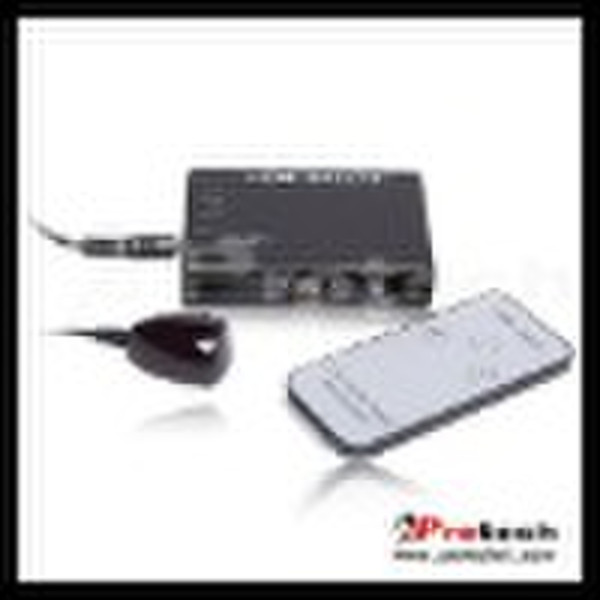HDMI Switch 3x1
原价: 6,00 USD
深圳宝安国际机场, 中国
生产能力:
100000 片 / 月

Kelvin Leung
联系人姓名
基本信息
| 牌子的名字 | Protech |
|---|---|
| 模式的数量 | PET0301S |
| 出生地 | Guangdong China (Mainland) |
ITEM: Mini hdmi switch, v1.3b hdmi switch, 3x1 hdmi switch MODEL: PET0301S With IR Receiver & remote control Compatible with HDMI1.3b,cat2, full HD 1080P. High performance up to 2.5Gbps. INTRODUCTION The 3x1 HDMI Switch routes high definition video (in multiple resolutions up to 1080p) and digital audio from any one of thethree sources to display unit.Three inputs accommodatethe simultaneous connection of up to five high definition video sources, such as satellite systems and HD DVD players. The output sends the high definition audio/video signals to a high definition display.This kind of the HDMI Amplifier Switcher not only has the key-press-switching function, but also has the IR remote control and intelligent function. FEATURES * Support HDMI 1.3b * Full HD 1080P * Support 12-bit Deep Color * High Performance up to 2.5Gbps * Switch easily between anyThree HDMI sources * Extends the range of HDMI compliant device by equalizing and re-clocking the HDMI signal * Maintains high resolution video - beautiful, sharp HDTV resolutions up to 1080p, 2k, and computer resolutions up to 1920 x 1200 are easily achieved* Supports 25Meters HDMI Cable on both ends of the Switcher * with IR receiver & remote control * HDMI pass-through * HDCP pass-through * No power needed Weights and Measurements Dimensions (Approx.) : 55W x80H x 16D mm Weight (Approx.) : 98gs Carton Packing:60*53*27cm 90pcs/cn G/W:14.00KG Package photo: HDMI Switch (3*1)Diagram Drawing Other Mini HDMI Switch(PET0301SS): hdmi switch 3x1 pigtail type(PET0301D) What is HDMI? HDMI (High-Definition Multimedia Interface) is a compact audio/video interface for transmitting uncompressed digital data. It represents a digitalalternative to consumer analog standards, such as radio frequency (RF) coaxial cable, composite video, S-Video, SCART, component video, D-Terminal, or VGA. HDMI connects digital audio/video sources—such as set-top boxes, upconvert DVD players, HD DVD players, Blu-ray Disc players, AVCHD camcorders,personal computers (PCs), video game consoles such as the PlayStation 3, Xbox 360, and AV receivers—to compatible digital audio devices, computermonitors, video projectors, and digital televisions. HDMI supports, on a single cable, any uncompressed TV or PC video format, including standard, enhanced, and high-definition video; up to 8 channels of compressed or uncompressed digital audio; and a Consumer Electronics Control (CEC) connection. The CEC allows HDMI devices to control each other when necessary and allows the user to operate multiple devices with one remote control handset. Because HDMI is electrically compatible with the signals used by Digital Visual Interface (DVI), no signal conversion is necessary, nor is there a loss of video quality when a DVI-to-HDMI adapter is used. As an uncompressed connection, HDMI is independent of the various digital television standards used by individual devices, such as ATSC and DVB, as these are encapsulations of compressed MPEG video streams (which can be decoded and output as an uncompressed video stream on HDMI). The HDMI standard was not designed to include passing closed caption data (for example, subtitles) to the television for decoding. As such, any closed caption stream has to be decoded and included as an image in the video stream(s) prior to transmission over an HDMI cable to be viewed on the DTV. This limits the caption style (even for digital captions) to only that decoded at the source prior to HDMI transmission. This also prevents closed captions when transmission over HDMI is required for upconversion. For example, a DVD player sending an upscaled 720p/1080i format via HDMI to an HDTV has no method to pass Closed Captioning data so that the HDTV can decode as there is no line 21 VBI in that format. HDMI products started shipping in late 2003. Over 850 consumer electronics and PC companies have adopted the HDMI specification (HDMI Adopters). In Europe, either DVI-HDCP or HDMI is included in the HD ready in-store labeling specification for TV sets for HDTV, formulated by EICTA with SES Astra in 2005. HDMI began to appear on consumer HDTV camcorders and digital still cameras in 2006.Shipments of HDMI were expected to exceed that of DVI in 2008, driven primarily by the consumer electronics market. HDMI History The HDMI Founders are Hitachi, Matsushita Electric Industrial (Panasonic/National/Quasar), Philips, Silicon Image, Sony, Thomson (RCA), and Toshiba.Digital Content Protection, LLC provides HDCP (which was developed by Intel) for HDMI.HDMI has the support of motion picture producers Fox, Universal, Warner Bros., and Disney, along with system operators DirecTV, EchoStar (Dish Network), and CableLabs. The HDMI Founders began development on HDMI 1.0 on April 16, 2002, with the goal of creating an AV connector that was backward-compatible with DVI. At the time, DVI-HDCP (DVI with HDCP) and DVI-HDTV (DVI-HDCP using the CEA-861-B video standard) were being used on HDTVs.HDMI 1.0 was designed to improve on DVI-HDTV by using a smaller connector and adding support for audio, enhanced support for YCbCr, and consumer electronics control functions. The first Authorized Testing Center (ATC), which tests HDMI products, was opened by Silicon Image on June 23, 2003, in California, United States.The irst ATC in Japan was opened by Panasonic on May 1, 2004, in Osaka. The first ATC in Europe was opened by Philips on May 25, 2005, in Caen, France.The first ATC in China was opened by Silicon Image on November 21, 2005, in Shenzhen. The first ATC in India was opened by Philips on June 12, 2008, in Bangalore.[28] The HDMI website contains a list of all the ATCs.
交货条款及包装
Packaging Detail: Neutral gift box,color box or custom design. Delivery Detail: 5-10 days
端口: Shenzhen
付款条款
Documents Against Acceptance
Documents Against Payment
Letter of credit
Telegraphic transfer
Western Union
-
支付方式
我们接受:









